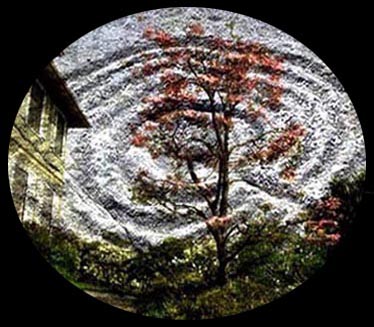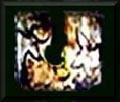OF PLACE ITSELF
Joel Weishaus
"What kind of thing is place itself? This is a question which we do not ask enough."(1)
Outside again, i flagged down two cops who were on horseback. One spoke English. He told me that he was not from Poland, but Portland. Setting:
Not feeling at home at any one place for any length of time has prevailed throughout my life. Whenever I thought I had moved to my "own place," a small wave would appear on the horizon that would slowly grow larger until it moved me to cross an unknown threshold again.
So I left the desert and one week later was walking the sodden streets of my new home reconnoitering directions. Some months later, I settled into an apartment with a forest out my back door. To the east, a district with red brick walls placed with skillful hands was quickly becoming "modern throwaway buildings of shiny glass surfaces (that) may momentarily dazzle the eye but do not mirror any reality other than themselves and their isolated counterparts across the street,"(2) streets lined with art galleries, coffeehouses, boutiques, and a water park alive with children and dogs.
Place is an "interval between two successive events or acts."(3) Restated with the Japanese term, ma, it "basically means an 'interval' between two (or more) spatial or temporal things and events." In addition,
"although ma may be objectively located as intervals in space and time, ultimately it transcends this and expresses a deeper level. Indeed, it takes us to a boundary situation at the edge of thinking and the edge of all processes of locating things by naming and distinguishing." (4)
With most architecture now modeled by computerized vector graphics, there is a scalable link between the digital and physical, beyond which Virtual Reality has made it possible to create environments the viewer can "walk through" as if cognitive mapping ability strictly speaking can, and indeed does, exist without the buttress of a traditional way of life, but it is then merely a skill rather than part of an indigenous holistic orientation to man and nature in a waking dream, and manipulate objects as if they were physically present. "Will only intuition and the 'deep structures of the psyche' arrest this digital runaway?"(5) What is not fantasy, in the sense of knowing it is, is shallow.
Context:
It was Prometheus—he who sees ahead—who gave the West its architectural footing. Before him, we "never knew of houses, brick built and warm, or the art of woodwork."(6) What felony got him chained to a rock, to the earth's foundation, with a vulture feasting on his recycling liver? Not stealing fire from the Gods, as the popular myth says. Prometheus's crime was giving us the imagination to interpret our dreams. "Any attempt to reclaim the destiny of the dream from the purposes of waking life is a Promethean Crime... because it robs the psyche of its underworld imagination and therefore insults the Gods."(7) No god can accept such an affront!
Not only did the Greek Gods have fundamental ties to their Aegean environment; like the weather, they were tricksters too. Thus, on the art of dream interpretation, James Hillman wrote:
"If we think back on any dream that has been important to us, as time passes and the more we reflect on it, the more we discover in it, and the more varied the directions that lead out of it. Whatever certainty it once might have given, shifts into complexes beyond clear formulations each time the dream is studied anew. The depth of even the simplest image is truly fathomless." (8)
In New Mexico, where adobe buildings with contoured corners rest on the earth they emulate, I read Le Corbusier, lover of right-angled walls, on the curves and loops of Arab architecture: It is "while walking, moving from one place to another that one sees how the arrangements of the architecture develop."(9) Bernard Tschumi continued by stating that architecture "is always hiding behind drawstrings, behind words, behind precepts, behind habits, behind technical constraints. Yet it is the very difficulty of uncovering architecture that makes it intensely desirable."(10)
Making:
Purposefully not animated, the images are palimpsests motivated by information and provocation that if given enough attention should draw one into the tide pools of an imaginal depth. "Perhaps by seeing how surfaces 'color' depths, we might contemplate our seeing things through their covering, or the contrast between apparent things and hidden things."(11)
Even though in most past digital projects I coded hyperlinks within the text, here there are none. One reason I moved away from this practice is—
"Even though the World Wide Web has made hypertext ubiquitous and presumably less startling and unfamiliar, the cognitive problems remain. Research continues to show that people who read linear text comprehend more, remember more, and learn more than those who read text peppered with links." (12)
Here we arrive at my signature trope "invagination," that, simply explained, engenders fragments of other voices into sentences as stratified embedments. However, invaginations are not like salting sentences with shards. Rather, they open ground to expose a narrative's artifacts.
Central to my concept of place is "electracy," which "is to digital media what literacy is to print,"(13) publishing within access to other writers, photographers, scholars, and general readers around the world. Learning from them, and from those who came before.
Reading:
In, "From Work to Text,"(14) Roland Barthes opened the path that several decades later led me to Digital Literary Art. Earlier, he wrote: "We read a text (of pleasure) the way a fly buzzes around a room: with sudden, deceptively decisive turns, fervent and futile."(15) A new genre requires a new way of reading. So I'd like to muse that Barthes was anticipating how to read texts such as these in a way that circulates the pleasure I felt while creating and being created by them.
Note: Designed at screen resolution 1600 X 900 pixels.
1- Casey, E.S. (1998) The Fate of Place. Berkeley: University of California Press.
2- Sardello, R. (1982) "City as Metaphor." Spring Journal. 3- Casey, E. (1982) “Getting Placed.” Spring Journal.
3- Turner, V. (1982 ) "Images of Anti-Temporality: An Essay in the Anthropology of Experience." Harvard Theological Review (April).
4- Pilgrim, R.B. (1986) "Intervals (Ma) in Space and Time: Foundations for a Religio-Aesthetic Paradigm in Japan." History of Religions. (February).
cognitive mapping's ability: G. Simeon, Eskimo Wayfinding and Spatial Orientation. Unpublished Manuscript. National Museums of Canada.
5- Connah, R. (2001) How Architecture Got its Hump. Cambridge: MIT Press.
6- Aeschylus (1957) "Prometheus Bound." In, L.R. Lind, Editor, Ten Greek Plays. Cambridge: The Riverside Press.
7- Hersh, J. (1982) "Model-Making and the Promethean Ego." Spring Journal.
8- Hillman, J. (1975) The Dream and the Underworld. New York: Harper & Row.
9- Le Corbusier. (1994) Paraphrased from, B. Colomina, Privacy and Publicity. Cambridge: MIT Press.
10- Tschumi, B. (1994) Architecture and Disjunction. Cambridge: MIT Press.
11- Sailer, S.S. (1996) "On the Redness of Salmon Bones, the Communicative Potential of Conger Eels, and Standing Tails of Air: Postmodern Images." Word & Image. (September).
12- Carr, N. (2010) “The Web Scatters Focus, Rewires Brain." Wired. 24 May. http://www.wired.com/magazine/2010/05/ff_nicholas_carr/all/1
13- Ulmer, G. L. (2003). Internet Invention: From Literacy to Electracy. New York: Longman.
14- Barthes, R. (1978) In, Image-Music-Text. New York: Hill and Wang.
15- Barthes, R. (1975) The Pleasure of the Text. New York: Hill and Wang.
Contents
For Susan Rowland, my wife and lover, forever.
For Steven, Barbara, Lucy and Annie Goldman.Northwest District,
Portland, Oregon.
5/ 2010- 3/ 2011

